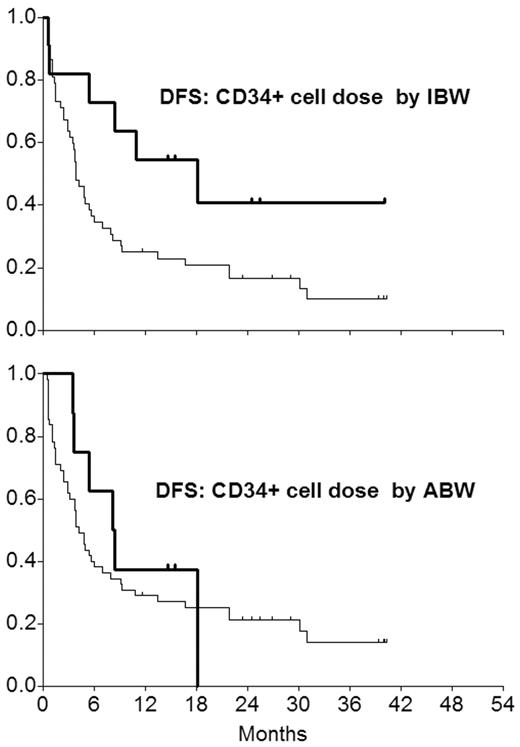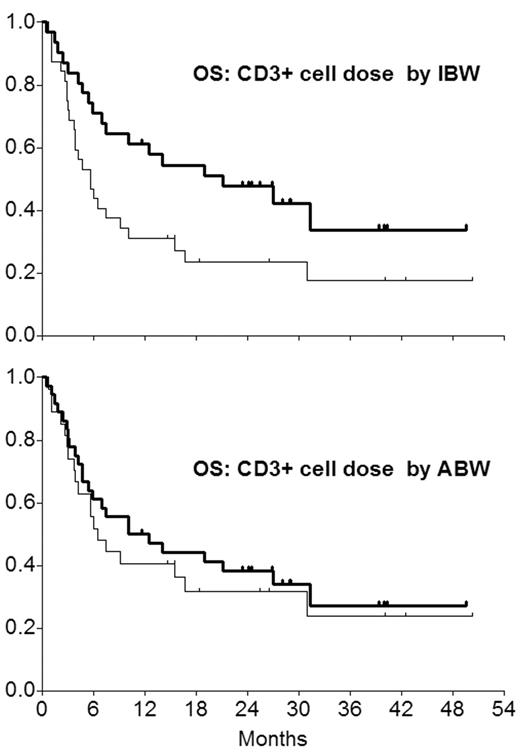Abstract
Graft CD34+ cell content based on ABW affects outcome after conventional allografts (
Singhal et al. BMT2000;26:489–96
). Engraftment after autologous (Ali et al. BMT2003;31:861–4
) and allogeneic (Cilley et al. BMT2004;33:161–4
) HSCT correlates better with CD34+ cell dose based on IBW than ABW. 63 patients (27–66 y, median 52) underwent submyeloablative HSCT from HLA-matched sibling (n=37), 10/10 allele-matched unrelated (n=19), or 1-locus/allele mismatched (n=7) donors for hematologic malignancies after 100 mg/m2 melphalan with (n=42; no prior autograft) or without (n=21; prior autograft) 50 mg/kg cyclophosphamide. GVHD prophylaxis comprised cyclosporine-mycophenolate with HLA-matched sibs and tacrolimus-mycophenolate with the rest. G/GM-CSF were not used. Supportive care was uniform. ABW and IBW values were 45–147 kg (median 79) and 52–85 kg (median 67) respectively. The ABW-IBW difference was −24% to +133% (median +16%); 9 patients were >5% underweight and 41 were >5% overweight. Chemotherapy doses were based on ABW for underweight patients, and adjusted weight for overweight (IBW + 25% of the ABW-IBW difference). The target CD34+ cell dose was 2–8 x106/kg IBW; preferably >6 and ≤ 8 based on prior findings (Singhal et al. ASH 2004). The CD34+ cell dose infused was 1.4–11.8 (median 5) by IBW and 1.2–9.3 (median 4.5) by ABW. The CD3+ cell dose (108/kg) was 0.9–14.9 (median 3) by IBW and 0.7–19.7 (median 2.7) by ABW. The 2-y cumulative incidence of relapse and transplant-related mortality (TRM) was 55% and 24% respectively. The 2-y probabilities of overall (OS) and disease-free (DFS) survival were 35% and 21% respectively.| . | CD34+ cell dose by IBW . | CD34+ cell dose by ABW . | ||||
|---|---|---|---|---|---|---|
| . | >6 and ≤ 8 (n=11) . | 6 or >8 (n=52) ≤ . | P . | >6 and ≤ 8 (n=8) . | 6 or >8 (n=55) ≤ . | P . |
| 3-y OS | 61% | 27% | 0.040 | 31% | 25% | 0.22 |
| 3-y DFS | 41% | 13% | 0.043 | 0% | 14% | 0.53 |
| 1-y TRM | 0% | 27% | 0.029 | 0% | 25% | 0.090 |
| 1-y Relapse | 45% | 48% | 0.34 | 63% | 47% | 0.70 |
| . | CD34+ cell dose by IBW . | CD34+ cell dose by ABW . | ||||
|---|---|---|---|---|---|---|
| . | >6 and ≤ 8 (n=11) . | 6 or >8 (n=52) ≤ . | P . | >6 and ≤ 8 (n=8) . | 6 or >8 (n=55) ≤ . | P . |
| 3-y OS | 61% | 27% | 0.040 | 31% | 25% | 0.22 |
| 3-y DFS | 41% | 13% | 0.043 | 0% | 14% | 0.53 |
| 1-y TRM | 0% | 27% | 0.029 | 0% | 25% | 0.090 |
| 1-y Relapse | 45% | 48% | 0.34 | 63% | 47% | 0.70 |
| . | CD3+ cell dose by IBW . | . | CD3+ cell dose by ABW . | |||
|---|---|---|---|---|---|---|
| . | <3 (n=31) . | 3 (n=32) ≥ . | P . | <3 (n=36) . | 3 (n=27) ≥ . | P . |
| 3-y OS | 34% | 18% | 0.032 | 27% | 24% | 0.54 |
| 3-y DFS | 24% | 4% | 0.043 | 18% | 7% | 0.58 |
| 1-y TRM | 10% | 35% | 0.008 | 17% | 30% | 0.12 |
| 1-y Relapse | 52% | 44% | 0.66 | 53% | 41% | 0.67 |
| . | CD3+ cell dose by IBW . | . | CD3+ cell dose by ABW . | |||
|---|---|---|---|---|---|---|
| . | <3 (n=31) . | 3 (n=32) ≥ . | P . | <3 (n=36) . | 3 (n=27) ≥ . | P . |
| 3-y OS | 34% | 18% | 0.032 | 27% | 24% | 0.54 |
| 3-y DFS | 24% | 4% | 0.043 | 18% | 7% | 0.58 |
| 1-y TRM | 10% | 35% | 0.008 | 17% | 30% | 0.12 |
| 1-y Relapse | 52% | 44% | 0.66 | 53% | 41% | 0.67 |
As the tables show, the CD34+ and CD3+ cell doses by IBW affected OS, DFS and TRM significantly. When ABW was used with the same numeric thresholds, the differences were less marked and not significant. The figures show the effect of the CD34+ cell dose on DFS and the CD3+ cell dose on OS.
Figure
Figure
Other cell dose thresholds based on ABW were also not found to be significant (data not shown). Based on these findings and our prior work on engraftment, we suggest using IBW rather than ABW to calculate cell doses for HSCT; for statistical analyses and for clinical practice if a specific cell dose is being targeted.
Author notes
Corresponding author
2005, The American Society of Hematology
2005



